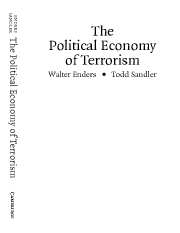Book contents
- Frontmatter
- Contents
- List of Tables and Figures
- Preface
- 1 Terrorism : An Introduction
- 2 The Dilemma of Liberal Democracies
- 3 Statistical Studies and Terrorist Behavior
- 4 Counterterrorism
- 5 Transference
- 6 International Cooperation : Dilemma and Inhibitors
- 7 Hostage Taking
- 8 After 9/11
- 9 The Economic Impact of Transnational Terrorism
- 10 Homeland Security
- 11 The Future of Terrorism
- References
- Author Index
- Subject Index
6 - International Cooperation : Dilemma and Inhibitors
Published online by Cambridge University Press: 06 July 2010
- Frontmatter
- Contents
- List of Tables and Figures
- Preface
- 1 Terrorism : An Introduction
- 2 The Dilemma of Liberal Democracies
- 3 Statistical Studies and Terrorist Behavior
- 4 Counterterrorism
- 5 Transference
- 6 International Cooperation : Dilemma and Inhibitors
- 7 Hostage Taking
- 8 After 9/11
- 9 The Economic Impact of Transnational Terrorism
- 10 Homeland Security
- 11 The Future of Terrorism
- References
- Author Index
- Subject Index
Summary
In a globalized world with a high volume of cross-border flows, transnational terrorism is a global public bad, while action to control or eliminate it is the quintessential global public good. As such, antiterrorism efforts yield nonrival benefits – enhanced security – received by all at-risk countries. The formation of far-flung terrorist networks has greatly increased the spatial dispersion of benefits derived from measures against these networks. The theory of public good supply teaches that as the dispersion of these measures' benefits increases, their underprovision worsens as providers fail to include the benefits that their efforts confer on others when deciding upon antiterrorism actions (see Chapter 4; Sandler, 1997, 2004).
The sheer volume of cross-border exchanges of all types makes it possible to monitor but a small fraction, thereby affording opportunities for terrorists to move personnel and equipment internationally. For example, over a half-billion people cross US borders each year. Also, 130 million motor vehicles, 2.5 million railcars, and 5.7 million cargo containers transit US borders annually (White House, 2004, p. 165). The combination of globalization and technological advances means that even the most secure borders may be penetrated by determined terrorists who utilize technologies (for example, communication advances) and apply innovative methods to circumvent security upgrades. Terrorists weigh relative risks to identify the least secure venue or weakest link at which to stage their attack against a targeted nation's assets.
- Type
- Chapter
- Information
- The Political Economy of Terrorism , pp. 134 - 159Publisher: Cambridge University PressPrint publication year: 2005

